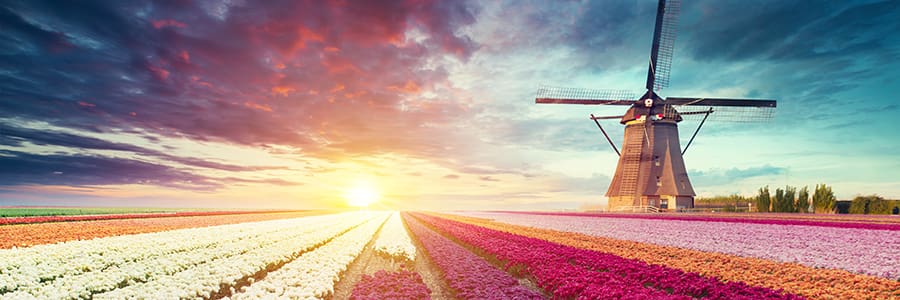
About The Dutch Canals
In Dutch a canal is a gracht (pronounced ‘khrakht’) and the main canals form the central grachtengordel (canal ring).
They may seem simply picturesque, but Amsterdam’s Canal Ring, built during the Golden Age of the early 1600s, is an extraordinary achievement, named a UNESCO World Heritage Site in 2010. With 165 canals spanned by 1753 bridges, more than any other city in the world, Amsterdam is truly a city like no other.
The canals of Amsterdam are but a few of the multitudes of canals that bisect The Netherlands that were built not for decorative reasons, but were critical for transportation and for keeping the sea at bay; today they offer a romantic backdrop for a journey filled with history, art, architecture, world-class cuisine, and, most famously in the springtime, tulips.
Still used for pleasure cruising as well as commercial transport, Holland and Belgium’s ultramodern river cruising boulevards are still full of life, with people working, shopping, and living their lives. Cruising with them, aboard a stylish and comfortable river cruise ship, offers the kind of up close and intimate perspective only available from the water. Each spring these tranquil waterways are your host to the millions of tulips and other flowers that bloom as they welcome the warmth of seasons changing.
Dutch Canal Stats
Length: More than 3,800 miles of navigable waterways in a country about the size of Maryland
Depth: Various depths
Source: More than 150 different canals and rivers
Mouth: Most waterways of The Netherlands empty into the North Sea
Locks: 96 navigable locks
Countries: The Netherlands
Learn More About the Dutch Canals
The Dutch canals, often referred to as the “Venice of the North,” are a network of waterways that crisscross the Netherlands, shaping both the landscape and the culture of the country. These canals have played a pivotal role in the history, economy, and daily life of the Dutch people for centuries. In this extensive exploration, we will delve into the origins, significance, and contemporary relevance of the Dutch canals.
Historical Origins
The history of Dutch canals can be traced back to the 17th century, known as the Dutch Golden Age. During this period, the Dutch Republic was a global economic and maritime powerhouse, thanks in part to its extensive canal system. The Dutch were not the first to construct canals, but they refined and expanded the existing waterways to create an intricate network that connected major cities, towns, and ports. One of the most famous canal projects from this era is the Canal Ring of Amsterdam. Built in the early 17th century, it’s a UNESCO World Heritage Site and a symbol of Dutch engineering prowess. Canals were used for transportation of goods, helping Amsterdam become a major trading hub. These waterways also facilitated the growth of other cities like Utrecht, Leiden, and Delft.
Economic Significance
The Dutch canals were the lifeblood of the country’s economy during the Golden Age. They allowed for the efficient transportation of goods, including spices, textiles, and raw materials, which were vital to the Dutch East India Company (VOC), one of the world’s first multinational corporations. The canals connected the ports to inland cities and enabled the distribution of goods throughout Europe. Moreover, the Dutch expertise in hydraulic engineering was crucial in creating a vast network of canals for land reclamation, drainage, and irrigation. Polders, low-lying tracts of land enclosed by dikes and drained by canals, were a remarkable achievement that expanded arable land and boosted agriculture.
Cultural Significance
Dutch canals have also deeply influenced the culture and lifestyle of the Netherlands. The iconic Dutch houseboats, known as woonboten, can often be seen moored along these waterways. These floating homes offer a unique living experience, allowing residents to be in close proximity to the heart of Dutch cities while enjoying the tranquility of the water. In addition to houseboats, many picturesque canal-side buildings, complete with ornate gables and charming facades, line the waterways. These buildings, often dating back centuries, give Dutch cities their distinctive character. Strolling along canal-side promenades, like Amsterdam’s Prinsengracht or Utrecht’s Oudegracht, is a quintessential Dutch experience, offering a glimpse into the country’s rich history and architectural heritage.
Recreational and Environmental Significance
While the Dutch canals retain their historical importance, they also serve modern purposes. Recreational activities such as boating, kayaking, and canal cruises are popular ways for both locals and tourists to enjoy the waterways. The canals provide a unique perspective on Dutch cities, allowing visitors to explore hidden gems and scenic vistas that are often inaccessible by land. From an environmental perspective, Dutch canals are integral to the country’s water management system. They help regulate water levels and mitigate the risk of flooding in a country that sits largely below sea level. This commitment to water management is exemplified by the Delta Works, a series of dams, sluices, locks, dykes, and storm surge barriers that protect the Netherlands from the North Sea’s threats.
Challenges and Preservation
Despite their enduring charm, Dutch canals face challenges in the modern era. Pollution, overuse, and maintenance issues can threaten the health of these waterways. Ensuring their preservation requires sustainable practices and investment in infrastructure. Efforts are also being made to adapt the canals to contemporary needs, such as improving water quality and enhancing connectivity between cities. Additionally, some areas are experimenting with innovative concepts like “water squares” that combine recreational spaces with water storage and filtration systems.
